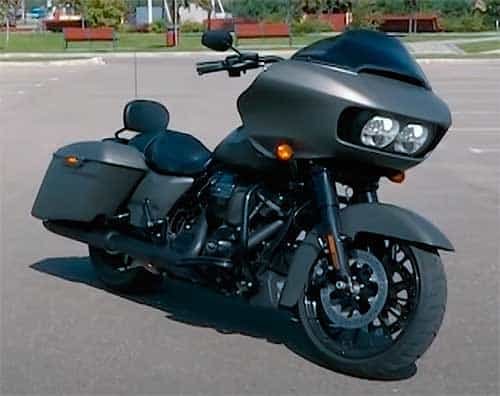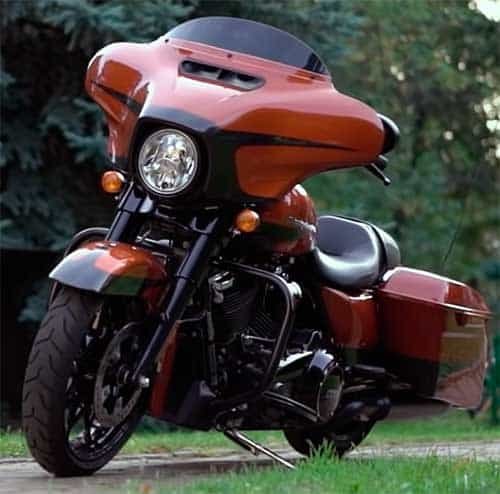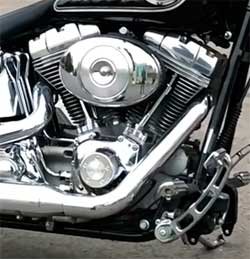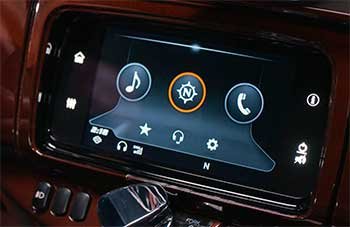When it comes to spending hours on your motorcycle, especially in scenarios where a majority of ride time is spent at highway or interstate speeds, the mental image of using a fully-fared touring motorcycle to make the journey is probably what comes to mind first. Faired motorcycles are considered to be the bees’ knees of long-distance motorcycle choices. With large front fairings that tuck the rider and passenger into a wind-blocked bubble, rider comforts such as Infotainment systems and ABS, and large motors that are capable of any highway demands, it’s hard to go wrong with using a touring bike for a long motorcycle trip.
Touring bikes such as the Harley-Davidson Road Glide, Electra Glide, and Street Glide check all the boxes for things you’d need in a touring bike, and on the surface, they all appear to be very similar motorcycles. So, what are the differences between these three bikes? All three of these motorcycles fall under the Harley-Davidson touring (FL) line of motorcycles, which means that all three bikes share the same frame and have many technical specifications in common. When it comes to dissecting how each bike is different, let’s trace back the history of the Touring line, which leads to the origin story for all three of these motorcycles. To do this, we’re going back to the 1960’s.
Table of Contents
Electra Glide

The original touring frame was the base for the earliest of the three motorcycles to begin production, which was the Electra Glide back in 1965. The Electra Glide began its production as the successor to the Duo-Glide, with its name having been derived from the electric starter that rolled out one model year prior in 1964. The first year of production featured the Panhead engine, which was in its last year of manufacture; it would be replaced with a Shovelhead motor beginning in 1966, providing it with a modest horsepower boost as a result. It began featuring what we now recognize as the single-headlight, fork-mounted Batwing fairing beginning in 1969, and the front fairing has become synonymous with touring bikes in the decades since.
Road Glide

The roots for the Harley-Davidson Road Glide don’t go back quite as far as the Electra Glide, but instead date back to 1979 with the Tour Glide predecessor; it was an unusual bike for its time due to the front fairing being fixed to the frame. In 1998, the Road Glide as we all know it today was introduced; 1998 would also be the only year that the Road Glide was available with a carbureted fuel system, and subsequent years came supplied with fuel injection. By this time, the engine had gone through a few revisions and Road Glides were being shipped with the Twin Cam 88 motor. The Road Glide also deviated from its Electra Glide predecessor by way of its frame-mounted, dual-headlight front fairing; this distinctive front fairing design is known as the Shark Nose, and the design has remained unchanged since its launch.
Street Glide

When compared to the Road Glide and Electra Glide models, the Street Glide could be considered as the new kid on the block when it comes to Harley-Davidson touring motorcycles. The Street Glide was first introduced in 2006, and presented itself as a modernized, yet pruned-down Electra Glide complete with (among other things) a smaller windscreen and a lower rear suspension setup, allowing for a slightly lower seat height. The front fairing on the Street Glide still retained a similar Batwing design as seen on the Electra Glide, and the Street Glide weighed slightly less than the Road Glide. The goal of the Street Glide was to market a no-nonsense touring bike that could still hold its own out on the highway, but could rival the Road Glide in many ways.
Touring Lineup Changes
With all touring motorcycles in Harley-Davidson’s lineup, there were two major revisions that occurred in both 2009 and in 2014, the latter of which is known as “Project Rushmore.” Back in 2009, Harley-Davidson made changes to the frame, swingarm, and engine mounting system for all bikes that used touring frames, and also changed the exhaust and front wheels that were available from the factory. The next (and perhaps the bigger) wave of changes to the touring line came with Project Rushmore in 2014. Project Rushmore was an endeavor by Harley-Davidson to stack their touring bikes with rider features and increased comfort features that would be directly felt during long rides. Added features included Daymaker headlights, GPS navigation, an Infotainment system with voice controls, and a waterproof media/phone compartment. Mechanically, Project Rushmore also added a high-output 103CI motor, and Reflex-linked ABS system.
With the history of the three touring-line motorcycles covered, let’s dive into the nitty-gritty details of all three models in their current model year configuration… and surprisingly, they are all remarkably similar at their cores. There are some slight differences between each of them, and we’ll get into those differences below.
Engines

The lineage for all three motorcycles has been traced back to the Panhead engine that was used in Electra Glides starting in 1965, followed by the Shovelhead for almost two decades, and was eventually supplanted by the Twin Cam 88 motor. The same Twin Cam 88 motor was found in the Road Glide when sales began in 1998, and got bumped up to a Twin Cam 96 before being replaced with the 107 motors in 2014. The Twin Cam 88 was used in the first several years of production of the Street Glide as well, before it was replaced with the newer, upgraded Milwaukee-Eight 103 engine starting with its 2012 model year motorcycle.
While past versions of each motorcycle have had some overlap in terms of which power plant was used, all three current model years of the Electra Glide Standard, Road Glide, and Street Glide share the same engine: a fuel-injected Milwaukee-Eight 107 bolted up to a 6-speed transmission, with similar displacement at roughly 111 ft-lb of torque, and each motorcycle estimating their fuel economy at around 43 mpg with a 6-gallon gas tank.

It’s when you move up to the higher trim level options that the engine options get a little spicier than the standard-issue 107 motor. The only trim level available for the Electra Glide for 2022 is the Electra Glide Standard, but for the Road Glide and Street Glide, there are multiple trim levels with additional drivetrain options. The Road Glide Special sold with a larger 114 motor, while the new Road Glide ST, CVO Road Glide, and CVO Road Glide Limited all feature a Milwaukee-Eight 117 V-twin motor. The Street Glide Special similarly sold with a 114 motor, and the Street Glide ST and CVO Street Glide sold with the larger and burlier 117 motor. However, like the 107-engine counterparts, each of the motorcycles found in the Special, ST, and CVO trims all feature a 6-gallon gas tank.
Features and Fairings
The standout motorcycle here is the Electra Glide Standard, which does not feature any kind of GPS or Infotainment system for the rider to utilize, nor does it come standard with a Daymaker headlamp or even a passenger seat. (Even Harley-Davidson themselves market this motorcycle towards “purists looking to disconnect and enjoy the distance.”) This may not be a bad thing by itself as the inclusion of Infotainment and GPS technology can technically be argued as distracting from the task of riding a motorcycle, and part of the charm of the Electra Glide line to begin with revolved around its single-saddle, barebones setup and Batwing-style front fairing.

When evaluating the Road Glide and Street Glide line of motorcycles, there is one noticeable difference that will help the untrained eye differentiate between the two motorcycles: the Road Glide has its gauge pods located below the Infotainment screen within the Shark Head style fairing, and the Street Glide features gauge pods above the Infotainment screen in its respective Batwing-Esque front fairing. Each one features a Boom! Box 4.3 Infotainment system, although the Road Glide’s display is relatively modest compared to the Street Glide package, which offers either a 4.3” (standard) or 6.5” (optional) display screen.
Moving into the Special, ST, CVO, and Limited trims, the options around the Infotainment receive a slight upgrade, although the layout remains fairly consistent to the base models. Each model is upgraded to the Boom! Box GTS Infotainment system. The Special and ST trims feature standard audio speakers, the CVO features a Rockford Fosgate Stage II speaker setup, and the CVO limited holds a Rockford Fosgate Stage I speaker kit. Each of the Special, ST, CVO, and Limited trims feature a 6.5” full-color TFT display.
Dimensions & Specifications
As one can expect when comparing motorcycles that share the same frame, each of the Electra Glide, Road Glide, and Street Glide motorcycles came in at the same exact 64-inch wheelbase. The rake and trail between each of these motorcycles are remarkably similar (the trail wavers by a maximum of .1 inches between all of the trim levels), and for the most part, tires and ground clearance are very closely matched between all of the motorcycles as well.
When comparing saddle heights, the Road Glide and CVO Road Glide are the lowest, with their 25.9” seat height catering nicely to the vertically-challenged Harley-Davidson riders of the world. The Street Glide, Street Glide Special, CVO Street Glide, and Electra Glide Standard matched the 26.1” seat height of the slightly taller Road Glide Special. Both the Road Glide ST and Street Glide ST come with a 26.7” seat height, due to the slightly sportier nature of the ST trim, but it’s the CVO Road Glide Limited that takes top honors with its 28.2” seat height.
Moving on to the heavy topic of weight, it’s no surprise that the top-tier CVO Road Glide Limited weighs in as the heavy hitter, at 963 lbs. On the other end of the spectrum, the mid-level Road Glide ST and Street Glide ST weigh in at 842 pounds and 814 pounds respectively, making them the lightest-weight option for each model. The weight of each motorcycle decreases as you move from top to bottom down the trim levels; the CVO Road Glide rolls in at 893 pounds, while the CVO Street Glide measures at 866 pounds. The Street Glide and Street Glide Special are nearly identical at 829 and 827 pounds, and the Road Glide and Road Glide Special are measured at 855 and 853 pounds. Last but certainly not least, the Electra Glide Standard tips the scales at 820 pounds, making it the second-lightest option behind the Street Glide ST.
Performance & Drivetrain
When it comes to measuring power with touring bikes, the amount of torque available is going to predict how responsive and snappy the motorcycle will be when you crack the throttle, but watching the engine torque RPMs in conjunction with torque will give a rough idea of how that engine will do on a long stretch of open highway.
Starting with the Electra Glide Standard, Road Glide, and Street Glide, each model is measured at 111 ft-lb of torque, with the engine torque value at 3250 RPM; this is marginally lower than the specs we will see with the other motorcycles. Both the Road Glide Special and Street Glide Special are clocked at 118 ft-lb of torque at 3250 RPM, inching them slightly higher than their base model counterparts. The Road Glide ST and Street Glide ST both measure 127 ft-lb torque at 3750 RPM, giving them a slight torque boost at a higher RPM to aid with power at higher speed, and placing them as the motorcycle with the highest torque available. The CVO Road Glide and CVO Street Glide both feature 126 ft-lb torque at 3750 RPM, putting them nearly identical to the ST variation, while the CVO Road Glide Limited takes a slight hit at 125 ft-lb torque at 3500 RPM.
Since there has been some chatter recently around the newly-revealed, sportier ST lineup by Harley-Davidson, let’s also take a closer look at the lean angles between each of the three touring motorcycles and their trim levels. With the ST trim style being primarily inspired by the King of the Baggers races, it would make sense that the ST trim would have the greatest lean angles. However, this is not the case; the CVO Road Glide and CVO Road Glide Limited have the biggest lean angles. The CVO Road Glide measures at 34 degrees for both left and right sides, while the CVO Road Glide Limited has a 33.4 degree (left) and 34.3 degree (right) lean angle. The Road Glide ST, Street Glide ST, CVO Street Glide, Road Glide Special, and Street Glide Special all have a 31 degree (left) and 32 degree (right) lean angle. The Electra Glide Standard, Road Glide, and Street Glide all have a more conservative 29 degree (left) and 31 degree (right) lean angle.
So, what’s the better deal?
As you can tell from the previous section, the Electra Glide, Road Glide, and Street Glide all have a lot in common, but they also have some distinct differences. If you’re currently in the market for a new Harley-Davidson touring bike and you’re considering one of these three models, it may be difficult to pin down the exact differences and make a firm conclusion without test-riding the motorcycle. Minor nuances such as lean angle and seat height may not matter to everyone, but for some, it could be a potential deal-breaker. Along with that is the personal taste in front fairings; some people love the Batwing look, and others prefer the Shark Head presentation.
If you’re looking for a motorcycle that is purpose-built for pure road use, and you either don’t need or want an Infotainment system (or you are perfectly happy with having this information on a smartphone), then the Electra Glide is a great entry into the Harley-Davidson touring world. It retains the base-model features found on all Harley-Davidson touring bikes, and the 107 motor means you’re getting the Harley power without feeling like the motor is too big. It’s also one of the lightest motorcycles in the comparison and has the second-lowest seat height available.
If you’re hoping for a motorcycle with some basic Infotainment features, and you prefer either the Shark Head front fairing or the Batwing-style front fairing, the Road Glide and Street Glide are cost-effective option that includes the Infotainment packages with 107 engines available for both. If you want better infotainment with a slightly beefier engine, the Road Glide Special and Street Glide Special feature a Milwaukee-Eight 114 engine upgrade, along with the more premium Boom! Box GTS Infotainment package.
For those that are looking for performance and improved speed and handling, the Road Glide ST and Street Glide ST will deliver to expectation, with the upgraded 117 motors in each motorcycle and minor dimensional changes that were done to improve overall power and handling (including a nice weight reduction difference from other Road Glide and Street Glide models). If you’re looking for all of the bells and whistles, the CVO and CVO Limited trim will deliver a nicer Infotainment package and the larger Milwaukee-Eight 117 engine.
It’s hard to go wrong with any of these bikes, but everyone’s needs are different, and one of these will probably work better for you than the others will. Consider what you’ll be using the motorcycle for, and hopefully, this guide will be able to help you decipher which one of the three will work best.
